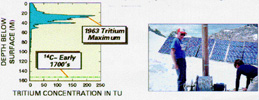 (210k) (210k)
|
Because the site was in a designated wilderness area, conventional drilling systems were not allowed. Instead, a solar- powered drill was used. Dust layers in the ice core were occassionally too faint to give reliable annual stratigraphic markers; therefore, chemical age-dating techniques in combination with estimated accumulation and ablation rates were used to construct a low-resolution chronology for generalized climatic interpretation and comparisons. Tritium (3H) concentrations exceeding 300 tritium units (TU) at a depth of 29 m below the surface corresponded to a snowfall deposited in 1963 during the peak of above ground nuclear bomb testing. Carbon-14 (14 C) age dating of a grasshopper leg entrapped at 152 m below the glacier surface indicated that ice near the bottom of the core formed from snow deposited in the early 1700's A.D. Furthermore, the positions of the tritium and 14C horizons within the ice core approximate the ages calculated from present-day estimations of average annual snowfall and summer ablation.

